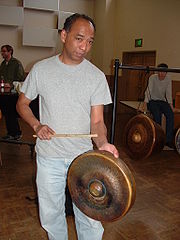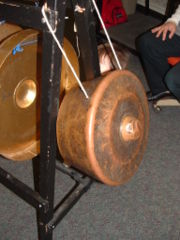
Babendil
Encyclopedia
The babandil is a single, narrow-rimmed Philippine
gong
used primary as the “timekeeper” of the Maguindanao
kulintang
ensemble.
or gandingan
. However, unlike the gandingan or the agung, the babendil has a sunken boss which makes the boss relatively non-functional. Because of their sunken boss, babendils are instead struck either at the flange or the rim, using either bamboo betays or a strip of rattan, producing a sharp, distinctive metallic clang and are sometimes considered “false gongs.” In fact, this distinction makes the babendil classified as a bell
in the Hornbostel-Sachs
classification (if it were struck at the boss, it would be considered a gong
.)
Babandils are normally made out of bronze but due to the scarcity of this metal in Mindanao
, most gongs, including the babendil are made out of more common metal such as brass, iron and even tin-can.

 The babendil traditionally could be played by either genders. In wooden kulintang ensembles, the kagul
The babendil traditionally could be played by either genders. In wooden kulintang ensembles, the kagul
is usually substituted for the babendil part. Among the Tausug, the Samal
and the Yakan
, their babendil-type instrument generally has gone into disuse (Instead, tempo is kept in check using the highest gong on the kulintangan . Solembat is term used by the Samal for the ostinato beat while the Yakan call that same beat, nulanting.) while among the Tagbanua, the babandil is used not only to keep the rhythm of pieces but also as a song accompaniment as well.
or frame drum
." Others suggests that since the babendil is closely related to the Javanese bebende or bende (a gong with similar characteristics and uses in the colotomic
gamelan
ensemble), it perhaps has relations with an ancient Indian kettle drum, behri, where ancient Sanskrit
indicated the bende was the bronze equivalent of the behri.
) babndir (Maranao
), bandil, babandil, babindil, bapindil, (Other Southern Philippine Groups), babandir (Tagbanua
, Batak
, Palaw’an
), banendir, tungtung, (Tausug), salimbal (Samal
) and the mapindil (Yakan
).
Philippines
The Philippines , officially known as the Republic of the Philippines , is a country in Southeast Asia in the western Pacific Ocean. To its north across the Luzon Strait lies Taiwan. West across the South China Sea sits Vietnam...
gong
Gong
A gong is an East and South East Asian musical percussion instrument that takes the form of a flat metal disc which is hit with a mallet....
used primary as the “timekeeper” of the Maguindanao
Maguindanao people
The Maguindanao are part of the wider Moro ethnic group, who constitute the sixth largest Filipino ethnic group. Their name means “people of the plains”.-Pre-Spanish:...
kulintang
Kulintang
Kulintang is a modern term for an ancient instrumental form of music composed on a row of small, horizontally-laid gongs that function melodically, accompanied by larger, suspended gongs and drums...
ensemble.
Description
The babandil usually has a diameter of roughly one foot making it larger than the largest kulintang gong and comparable to the diameter of the agungAgung
The agung is a set of two wide-rimmed, vertically-suspended gongs used by the Maguindanao, Maranao and Tausug people of the Philippines as a supportive instrument in kulintang ensembles...
or gandingan
Gandingan
The gandingan is a Philippine set of four large, hanging gongs used by the Maguindanao as part of their kulintang ensemble. When integrated into the ensemble, it functions as a secondary melodic instrument after the main melodic instrument, the kulintang...
. However, unlike the gandingan or the agung, the babendil has a sunken boss which makes the boss relatively non-functional. Because of their sunken boss, babendils are instead struck either at the flange or the rim, using either bamboo betays or a strip of rattan, producing a sharp, distinctive metallic clang and are sometimes considered “false gongs.” In fact, this distinction makes the babendil classified as a bell
Bell (instrument)
A bell is a simple sound-making device. The bell is a percussion instrument and an idiophone. Its form is usually a hollow, cup-shaped object, which resonates upon being struck...
in the Hornbostel-Sachs
Hornbostel-Sachs
Hornbostel–Sachs is a system of musical instrument classification devised by Erich Moritz von Hornbostel and Curt Sachs, and first published in the Zeitschrift für Ethnologie in 1914. An English translation was published in the Galpin Society Journal in 1961...
classification (if it were struck at the boss, it would be considered a gong
Gong
A gong is an East and South East Asian musical percussion instrument that takes the form of a flat metal disc which is hit with a mallet....
.)
Babandils are normally made out of bronze but due to the scarcity of this metal in Mindanao
Mindanao
Mindanao is the second largest and easternmost island in the Philippines. It is also the name of one of the three island groups in the country, which consists of the island of Mindanao and smaller surrounding islands. The other two are Luzon and the Visayas. The island of Mindanao is called The...
, most gongs, including the babendil are made out of more common metal such as brass, iron and even tin-can.

Technique
The babendil could be played while standing or when seated with the babendil hung half a foot from the floor. Proper technique requires the player to hold the babendil vertically, angled away from the body, with the gong held at the rim between their thumb and four fingers. With their thumb parallel to the rim of the gong, the players strikes the rim of the gong using their betay to play fundamental patterns that are similar to the drum pattern on the dabakan or the beat of the lower-pitched agung.Uses

Kagul
Also called tagutok , bantula or tagungtung and kuratung .The kagul is a type of Philippine bamboo scraper gong/slit drum of the Maguindanaon and Visayans with a jagged edge on one side, played with two beaters, one scarping the jagged edge and the other one making a beat...
is usually substituted for the babendil part. Among the Tausug, the Samal
Samal
-Cultures:* The Sama languages of the Sulu Archipelago in island Southeast Asia* The ethnic groups that speak this language , see Samal people-In Turkey:* An ancient Hittite city, now the Zincirli archaeological site in southern Turkey...
and the Yakan
Yakan
The Yakan people are among the major indigenous tribes in Mindanao. Having a significant number of followers of Islam, it is considered as one of the 13 Moro groups in the Philippines. There are also a good number of Christians in this tribe as a result of the conversion of the line of Datu Kalun -...
, their babendil-type instrument generally has gone into disuse (Instead, tempo is kept in check using the highest gong on the kulintangan . Solembat is term used by the Samal for the ostinato beat while the Yakan call that same beat, nulanting.) while among the Tagbanua, the babandil is used not only to keep the rhythm of pieces but also as a song accompaniment as well.
Origins
The origins of the word "babendil" could either be traced from the Middle East or the Indian Subcontinent. Scholars suggest the name babendil is derived from the Arabic word, bandair, meaning, “circular-type, pan-Arabic, tambourineTambourine
The tambourine or marine is a musical instrument of the percussion family consisting of a frame, often of wood or plastic, with pairs of small metal jingles, called "zils". Classically the term tambourine denotes an instrument with a drumhead, though some variants may not have a head at all....
or frame drum
Frame drum
A frame drum is a drum that has a drumhead width greater than its depth. Usually the single drumhead is made of rawhide or man-made materials. Shells are traditionally constructed of bent wood scarf jointed together; plywood and man-made materials are also used. Some frame drums have mechanical...
." Others suggests that since the babendil is closely related to the Javanese bebende or bende (a gong with similar characteristics and uses in the colotomic
Colotomy
Colotomy is a term coined by the ethnomusicologist Jaap Kunst to describe the rhythmic patterns of the gamelan. It refers to the use of specific instruments to mark off nested time intervals, or the process of dividing rhythmic time into such nested cycles...
gamelan
Gamelan
A gamelan is a musical ensemble from Indonesia, typically from the islands of Bali or Java, featuring a variety of instruments such as metallophones, xylophones, drums and gongs; bamboo flutes, bowed and plucked strings. Vocalists may also be included....
ensemble), it perhaps has relations with an ancient Indian kettle drum, behri, where ancient Sanskrit
Sanskrit
Sanskrit , is a historical Indo-Aryan language and the primary liturgical language of Hinduism, Jainism and Buddhism.Buddhism: besides Pali, see Buddhist Hybrid Sanskrit Today, it is listed as one of the 22 scheduled languages of India and is an official language of the state of Uttarakhand...
indicated the bende was the bronze equivalent of the behri.
Other derivative names
Also called: babendir, (MaguindanaoMaguindanao people
The Maguindanao are part of the wider Moro ethnic group, who constitute the sixth largest Filipino ethnic group. Their name means “people of the plains”.-Pre-Spanish:...
) babndir (Maranao
Maranao
Maranao is the term used for the people of Lanao, a predominantly Muslim region in the Philippines island of Mindanao. They are famous for their artwork, sophisticated weaving, wood and metal craft, and their epic literature...
), bandil, babandil, babindil, bapindil, (Other Southern Philippine Groups), babandir (Tagbanua
Tagbanua
The Tagbanua tribe, one of the oldest tribes in the Philippines, can be mainly found in the central and northern Palawan. Research has shown that the Tagbanua are possible descendants of the Tabon Man; thus, making them one of the original inhabitants of the Philippines...
, Batak
Batak (Philippines)
The Batak are one of about 70 indigenous peoples of the Philippines. They are located in the northeastern portions of Palawan, a relatively large island in the southwest of the archipelago. There are only about 500 Batak remaining. Also called Tinitianes, the Batak are considered by anthropologists...
, Palaw’an
Palawan
Palawan is an island province of the Philippines located in the MIMAROPA region or Region 4. Its capital is Puerto Princesa City, and it is the largest province in the country in terms of total area of jurisdiction. The islands of Palawan stretch from Mindoro in the northeast to Borneo in the...
), banendir, tungtung, (Tausug), salimbal (Samal
Samal
-Cultures:* The Sama languages of the Sulu Archipelago in island Southeast Asia* The ethnic groups that speak this language , see Samal people-In Turkey:* An ancient Hittite city, now the Zincirli archaeological site in southern Turkey...
) and the mapindil (Yakan
Yakan
The Yakan people are among the major indigenous tribes in Mindanao. Having a significant number of followers of Islam, it is considered as one of the 13 Moro groups in the Philippines. There are also a good number of Christians in this tribe as a result of the conversion of the line of Datu Kalun -...
).

